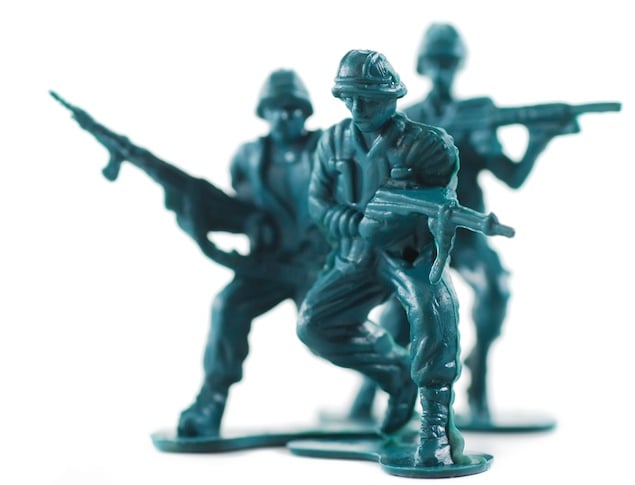“Nobody expects the Spanish inquisition.” –Monty Python
When the ships were sunk and the dead counted, this much was clear: The most expensive war game in history had not gone according to plan.
In July 2002, the U.S. armed forces staged a quarter-billion-dollar simulation of a war with a rogue Middle Eastern country in the Persian Gulf. Coming so close to a real war with Iraq, military planners hoped the exercise would be especially instructive. The game was played using some real people and equipment, but it was made more convincing through the application of Hollywood-style computer animation. Commanders watched on screens as huge numbers of troops prepared for battle, and as aircraft and ships deployed in the Persian Gulf.
The U.S. side, or Blue Team, had spent months studying their adversary, the Red Team, They knew the size of Red’s land, sea, and air forces. Where all its command and control systems were located. They knew all the weak spots in its national infrastructure–the power grid, national communications systems. And because the Blue leaders believed they’d accounted for Red’s every possible move on the battlefield, they expected to defeat the enemy in short order.
But on the first day of the game, Red failed to respond to Blue’s demand for immediate and unconditional surrender. Unbeknownst to Blue, the Red commander had sent attack orders to his forces through unusual means, including motorcycle couriers, calls shouted from minarets, and World War II-era light signals. They were all modes of communication that Blue had never accounted for. Why would Red use them when he had satellites and telephones?
Expecting a quick end to the battle, the Blue fleet instead found itself surrounded by a swarm of small, seemingly innocuous Red boats. Without warning, the small boats let loose a devastating volley of cruise missiles at the Blue fleet, which, never having anticipated such an aggressive move, was helpless to respond. Some of the boats were loaded with explosives and rammed into their gargantuan adversaries. By the end of the attack, several Blue vessels sat at the bottom of the Persian Gulf. Had this been a real expertise, it’s estimated that 20,000 U.S. forces would be dead.
The story of Millennium Challenge is one of the most frequently cited modern examples of an ancient maxim of warfare: Know your enemy. Blue’s commanders failed in large part because they evinced a profound lack of empathy. They had never anticipated that Red would act so different than them. They had not put themselves in the minds of a devious and desperate dictator who, knowing he was outmatched in a head-to-head fight, would resort to asymmetric tactics–and some centuries old ones, at that. Millennium Challenge became an object lesson in the dangers of not thinking like your enemy, and of the potential gains of doing so.
The lessons of that war game seem especially poignant now, as tensions mount with North Korea and the United States attempts to curb Iran’s nuclear ambitions. We are reminded that U.S. intelligence about its adversaries is limited, and often not very good. This week, the Wall Street Journal reported that “after a high-visibility display of military power aimed at deterring North Korean provocations, the White House is dialing back the aggressive posture amid fears that it could inadvertently trigger an even deeper crisis.” A previously devised “playbook” of escalating displays of force was apparently based on a set of assumptions about North Korea’s behavior that might not be panning out.
“The concern was that we were heightening the prospect of misperceptions on the part of the North Koreans, and that that could lead to miscalculations,” a senior administration official told the newspaper.
“Officials said the U.S. didn’t believe North Korea had any imminent plans to take military action in response to the exercises,” the Journal reported. “Rather, the shift reflects concerns within the administration that the North, caught off guard, could do something rash, contrary to intelligence assessments showing that it is unlikely to respond militarily to the U.S. show of force.” [Emphasis mine.]
Military planners don’t like to be caught by surprise. As it happened, the ones who planned Millennium Challenge were so chagrined by Red’s audacious and hugely successful attack that they reset the game. The Blue ships were magically floated back to the surface. The dead were brought back to life. And as the game played on for another two weeks, the Red Team was barred from engaging in any more unexpected tactics. The Red commander quit the game in protest. The Blue Team, playing with the rules in its favor, won round two in a rout.
The military is fond of its war games, and for good reason. Even when the outcome is unpredictable–or in the case of Millennium Challenge, undesirable–the play itself is instructive. When properly constructed, war games convince players that the stakes are real. Even when played sitting around a table using rudimentary set pieces–pieces of paper, toy planes and ships–players somehow see past the artifice and behave as if the scenario were real.
“Gaming’s transformative power grows out of its particular connections to storytelling,” write Peter Perla and ED McGrady, two game designers, in a paper published by the Naval War College. A good game creates the kind of willing suspension of disbelief you experience when you watch an engrossing movie or read a page-turning book. But since play is not a passive experience, gaming heightens that sense of belief. “Gaming, as a story-living experience, engages the human brain, and hence the human being participating in a game, in ways more akin to real-life experience than to reading a novel or watching a video,” Perla and McGrady write.
The effects of games linger after the play has finished. The authors recall a bioterrorism war game run by the White House in 1998 that so impressed President Clinton he asked Congress to increase the counterterrorism budget by $294 million to defend the nation from weaponized pathogens. The President had been primed for the plausibility of a bio-attack by a fictional account he’d been reading in Richard Preston’s novel The Cobra Event. (Preston is also the author of a non-fiction book on disease outbreaks, Hotzone, that is all the more terrifying because it’s true.)
The key to a successful game is that it not only seem real, but that it present the players with an adversary that they would probably never imagine, an event that is “at odds with how you see the world,” write Perla and McGrady. The crazed scientist who builds a deadly virus. The rogue commander who uses suicidal tactics. Absent this surprise, “it is unlikely that any game architecture could present an effective, realistic scenario…”
Of course, in Millennium Challenge, the Blue Team faced just such an enemy. Did they learn from that experience? A year later, U.S. forces easily defeated the military of Saddam Hussein in Iraq. But then, for the next eight years, they found themselves locked in an asymmetric war with insurgents, for which no one had planned. Blue did not think like Red.










